Do you have a question about the Siemens SIPROTEC 4 and is the answer not in the manual?
| Product Series | SIPROTEC 4 |
|---|---|
| Category | Protection Device |
| Manufacturer | Siemens |
| Device Type | Protection Relay |
| Communication Protocols | IEC 61850, PROFIBUS, Modbus, DNP3, IEC 60870-5-103 |
| Input Voltage | 24-250 V DC / 100-240 V AC |
| Operating Temperature | -25 °C to +70 °C (depending on the specific model) |
| Weight | Varies depending on the specific model |
| Display | LCD (Liquid Crystal Display) |
| Number of Inputs | Varies depending on the specific model |
| Number of Outputs | Varies depending on the specific model |
| Hardware | Modular design |
| Current Transformer Inputs | 1A or 5A standard |
| Voltage Transformer Inputs | Typically 100V or 110V (depending on the specific model) |
| Binary Inputs | Varies depending on the specific model |
| Binary Outputs | Varies depending on the specific model |
| Auxiliary Power Supply | 24-250 V DC / 100-240 V AC |
| Housing | Metal case |
| Application | Power System Protection, Automation, Control |
| Functions | Overcurrent protection, earth fault protection, distance protection, differential protection, frequency protection, voltage protection, etc. (depending on the specific model) |
Describes the manual's scope, device functions, and settings.
Identifies intended readers like protection engineers and operating personnel.
Specifies the manual applies to SIPROTEC 4 Multi-Functional Protective Relay with Local Control 7SJ62/64, Firmware V4.9.
States compliance with EMC and Low-voltage directives and relevant IEC/VDE standards.
Mentions IEEE Std C37.90 as an additional standard.
Describes the device's microprocessor, digital processing, and analog inputs.
Details the versatility of SIPROTEC 4 7SJ62/64 relays for protection, control, and monitoring in various networks.
Lists general characteristics like microprocessor, digital processing, electrical separation, and operation methods.
Explains how device functions and parameters can be modified using DIGSI or the front panel.
Describes overcurrent protection as the main function, with four elements per phase and ground current.
Covers directional overcurrent protection with four elements each for phase and ground currents.
Details the function for dynamically changing pickup values of overcurrent protection.
Explains the evaluation of current via sensitive or insensitive ground current transformers.
Describes protection against undervoltage and overvoltage, with two elements each for overvoltage and undervoltage protection.
Explains evaluation of negative sequence components of currents with definite-time and inverse-time elements.
Covers motor starting protection, restart inhibit, and load jam protection for motors.
Details protection against abnormally high and low frequencies in systems and machines.
Describes undervoltage-controlled reactive power protection for mains decoupling purposes.
Explains the function designed to prevent thermal overloads damaging protected equipment.
Covers extensive monitoring capabilities for hardware, software, and measured values.
Describes ground fault detection operation modes, measurement principles, and applications.
Details the function to detect intermittent ground faults and accumulate their duration.
Explains the directional intermittent ground fault protection designed to selectively detect faults in cable systems.
Describes the integrated three-pole, single-shot and multi-shot automatic reclosure (AR).
Covers measurement of distance to short-circuit faults as a supplement to protection functions.
Details the function that monitors proper tripping of the relevant circuit breaker.
Explains how users can create up to 20 flexible protection functions and configure them.
Provides an application example of the reverse power protection function.
Details configuration options for synchronization functions and modes of operation.
Explains the RTD box as an external device for temperature detection.
Describes the phase rotation function via binary input and parameter.
Coordinates execution of protection and auxiliary functions and processes decisions.
Covers general device functions like device control, messages, fault records, etc.
Details the impacts on protective functions when using only one voltage transformer.
Describes control commands, operation modes, and interlocking conditions.
Details general diagrams, voltage and current transformer connections, and binary inputs/outputs.
Explains pin assignments of serial, time synchronization, and Ethernet interfaces.
Provides warnings and steps for safe commissioning and testing.
Describes final checks, settings verification, clock synchronization, and resetting counters.
Includes analog inputs, auxiliary voltage, binary inputs/outputs, communication interfaces, and EMC tests.
Provides operating modes, measuring methods, setting ranges, tolerances, and influencing variables.
Details operating modes, measuring method, setting ranges, trip time curves, dropout time curves, tolerances, and influencing variables.
Covers time overcurrent elements, determination of direction, and times.
Describes setting ranges, functional limits, and crossblock options for inrush restraint.
Lists timed changeover of settings, setting ranges, functional limits, times, dropout ratio, tolerances, and influencing variables.
Provides current elements, operating times, dropout ratios, tolerances, and influencing variables.
Details setting ranges, increments, tolerances, and influencing variables for undervoltages and overvoltages.
Lists setting ranges, increments, functional limits, times, dropout ratio, tolerances, and influencing variables.
Provides setting ranges, increments, functional limits, trip time curves, dropout time curves, tolerances, and influencing variables.
Details setting ranges, increments, trip curve, dropout ratio, tolerances, and influencing variables.
Lists setting ranges, increments, restart threshold, rotor overload detection, restart time, equilibrium time, and minimum inhibit time.
Details setting ranges, increments, timers, dropout ratio, tolerances, and influencing variables.
Lists setting ranges, increments, dropout difference, time delays, tolerances, and influencing variables.
Details measured values, modes of operation, pickup thresholds, tripping delay, release delay, dropout delay, tolerances, and influencing variables.
Covers setting ranges, increments, trip characteristic, dropout ratios, tolerances, and influencing variables.
Details displacement voltage pickup, phase detection, current elements, direction determination, and tolerances.
Lists pickup threshold, pickup extension time, ground fault accumulation time, reset time, number of pickups, times, tolerances, and influencing variables.
Details setting ranges, increments, dropout ratio, tolerances, and influencing variables.
Lists number of reclosures, blocking of 79, dead times, and reclosing programs.
Covers measurement of distance to short-circuit faults as a supplement to protection functions.
Details setting ranges, increments, times, tolerances, and influencing variables.
Explains how users can create up to 20 flexible protection functions and configure them.
Covers operating modes, additional release conditions, voltages, permissible differences, circuit breaker, threshold ASYN/SYN, matching, and times.
Explains the RTD box as an external device for temperature detection.
Details function blocks, device-specific CFC blocks, general limits, and renaming messages.
Lists operational measured values, long-term averages, min/max measurement setup, and conversion formulas.
Describes number of controlled switching devices, interlocking, messages, control commands, and logic.
Provides dimensional drawings for various housing sizes and mounting types.
Lists ordering information for 7SJ62 with V4.9 firmware.
Lists ordering information for 7SJ64 with V4.9 firmware.
Lists available accessories for the devices.
Provides general diagrams for 7SJ62 in panel flush or cubicle mounting.
Shows general diagrams for 7SJ62 in panel surface mounting.
Illustrates interface assignments for 7SJ62 panel surface mounting.
Provides general diagrams for 7SJ64 in panel flush or cubicle mounting.
Shows general diagrams for 7SJ64 in panel surface mounting.
Illustrates general diagrams for 7SJ64 with detached operator panel.
Shows general diagrams for 7SJ64 panel surface mounting without operator panel.
Details connector assignments for various interfaces like RS232, RS485, etc.
Provides connection examples for current transformers across all devices.
Shows connection examples for voltage transformers 7SJ621 and 7SJ622.
Illustrates connection examples for voltage transformers 7SJ623, 7SJ624, 7SJ625, 7SJ626, 7SJ64.
Provides a connection example for high-impedance ground fault differential protection.
Shows a connection example for the RTD box.
Details required minimum effective accuracy limiting factor and resulting rated accuracy limiting factor.
Explains conversion into other classes for current transformers.
Describes requirements for cable core balance current transformers for sensitive ground fault detection.
Lists preset LED displays and their corresponding function numbers and descriptions.
Provides binary input presettings for all devices and ordering variants.
Lists further output relay presettings for 7SJ62 and 7SJ64.
Details the default functions assigned to the device's function keys.
Explains the predefined measured value pages available and how to select the start page.
Lists CFC charts supplied with the SIPROTEC device for device and system logic, and setpoints.
Compares protocol functions, measured values, fault recording, remote relay setting, user-defined messages, time synchronization, and commissioning aids.
Details how to enable/disable functions and configure parameters for different protection functions.
Provides regional presettings and configuration options for various parameters.
Lists descriptions, functions, log buffers, and configuration details for various information items.
Lists group alarms and their composition.
Details operational measured values, long-term averages, min/max measurement setup, and conversion formulas.
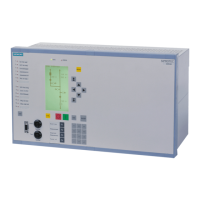
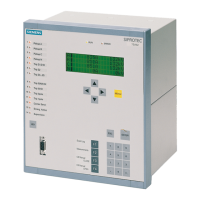
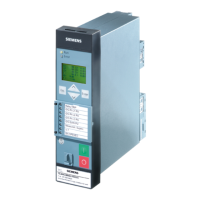
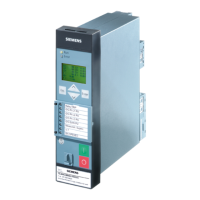
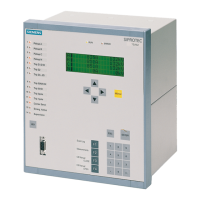


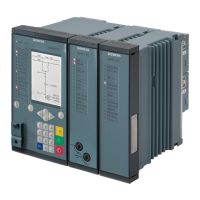
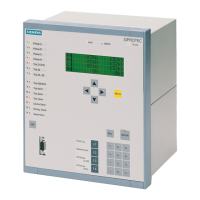
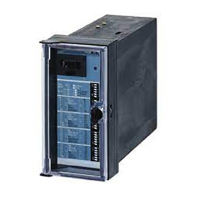

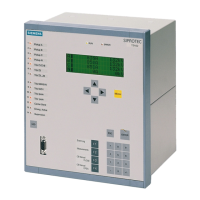
